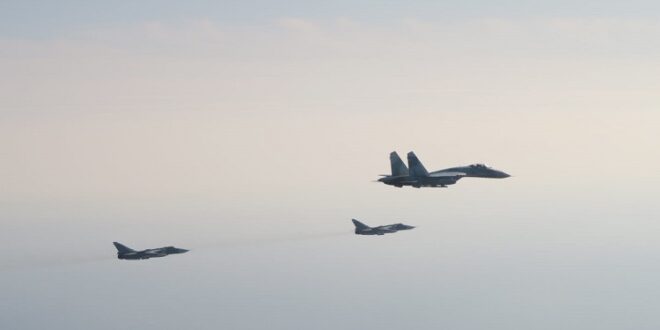As tensions continue to rise between NATO and Russia, the skies have become a battleground for both sides. The air confrontation between NATO and Russian fighter jets has escalated in recent years, with each side accusing the other of aggressive behavior. This dangerous game of cat and mouse has raised concerns about the potential risks involved and the impact it could have on international relations. In this article, we will explore the rising tensions between NATO and Russia, examine the escalation of the air confrontation, discuss the risks involved, analyze its impact on global politics, and consider its implications for future international relations.
The Rising Tensions Between NATO and Russia
Over the past few years, tensions between NATO and Russia have been steadily rising. The annexation of Crimea by Russia in 2014 marked a turning point in the relationship between the two powers, with NATO condemning Russia’s actions as a violation of international law. Since then, there have been numerous incidents involving Russian fighter jets intercepting NATO planes and ships in international airspace and waters.
These incidents have only served to heighten tensions between the two sides, with both sides accusing each other of aggressive behavior. NATO has accused Russia of violating international norms by conducting unsafe intercepts, while Russia has accused NATO of increasing its military presence near its borders. As a result, both sides have increased their military activities in Europe, leading to an escalation of the air confrontation between them.
The Escalation of the Air Confrontation
As tensions between NATO and Russia continue to rise, so too does the frequency of air confrontations between their fighter jets. In recent years, there has been a significant uptick in the number of incidents involving Russian aircraft flying dangerously close to NATO planes, often without warning or communication.
These encounters have become increasingly aggressive and provocative, with both sides accusing the other of engaging in unsafe maneuvers and violating international airspace. The situation has escalated to the point where some experts fear that a miscalculation or miscommunication could lead to a catastrophic accident or even a military conflict.
Despite efforts by both sides to de-escalate tensions, the air confrontation shows no signs of abating. As such, it is imperative that leaders on both sides work together to find a peaceful resolution before it is too late.
The Risks of the Air Confrontation
As tensions continue to rise between NATO and Russia, the risks of an air confrontation are becoming increasingly concerning. The potential for accidents or miscalculations is high, particularly when fighter jets from both sides are flying in close proximity to each other. Even a small mistake could lead to a catastrophic outcome.
Furthermore, the use of aggressive tactics by both sides increases the likelihood of an unintended incident. Russian fighter jets have been known to fly dangerously close to NATO planes, while NATO pilots have reported being “buzzed” by Russian aircraft. These actions not only increase the risk of collision but also create a tense and unpredictable environment that could easily escalate into something more serious.
The risks of an air confrontation extend beyond just the immediate danger to pilots and aircraft. A military conflict between NATO and Russia would have far-reaching consequences for global security and stability. It is essential that both sides take steps to reduce tensions and avoid any unnecessary confrontations in the air or on the ground.
The Impact of the Air Confrontation
The ongoing air confrontation between NATO and Russian fighter jets has had a significant impact on the security landscape of Europe. The constant encounters between military aircraft from both sides have led to an increase in tensions and a sense of insecurity among the people living in the region.
One of the most significant impacts of this air confrontation is the strain it has put on diplomatic relations between NATO and Russia. The frequent incidents have made it difficult for both sides to engage in constructive dialogue, leading to a breakdown in communication and cooperation. Moreover, these confrontations have also resulted in increased military spending by both sides, diverting resources that could be used for other critical areas such as healthcare, education, and infrastructure development.
Furthermore, there is also a growing concern about the potential for accidents or miscalculations during these confrontations. Any mistake could lead to an unintended escalation of hostilities, which could have catastrophic consequences for both sides. Therefore, it is essential that both NATO and Russia take steps to reduce tensions and prevent any accidental incidents from occurring.
In conclusion, the impact of this air confrontation cannot be underestimated. It has created an atmosphere of mistrust and insecurity between NATO and Russia while diverting resources away from more pressing issues. It is imperative that both sides find ways to de-escalate tensions before any tragic incident occurs.
The Implications of the Air Confrontation
The air confrontation between NATO and Russian fighter jets has significant implications for both parties involved. Firstly, it highlights the growing tensions between the two military powers and the potential for a larger conflict to arise. The increasing frequency of these encounters is a clear indication that neither side is willing to back down, which could lead to further escalation.
Moreover, the air confrontation poses a risk to civilian aircraft in the region. With fighter jets flying at high speeds and engaging in dangerous maneuvers, there is always the possibility of an accident occurring. This could have devastating consequences not only for those on board but also for international relations between countries.
Additionally, the air confrontation has implications for global security as a whole. It sends a message that military aggression is still prevalent in today’s world and that diplomatic efforts may not always be enough to resolve conflicts peacefully. The continued tension between NATO and Russia could also lead to other countries taking sides or becoming involved in the conflict, further destabilizing the region.
Overall, it is crucial that both NATO and Russia take steps towards de-escalation and finding peaceful solutions to their differences. The implications of continued air confrontations are too great to ignore, and it is essential that all parties involved prioritize diplomacy over military action.
Conclusion
In conclusion, the air confrontation between NATO and Russian fighter jets is a clear indication of the rising tensions between the two superpowers. The escalation of this conflict poses significant risks to both sides, including potential accidents or miscalculations that could lead to catastrophic consequences. Furthermore, the impact of this confrontation extends beyond just military implications, as it also affects diplomatic relations and global security. It is crucial for both NATO and Russia to find a way to de-escalate this conflict and engage in productive dialogue to prevent further escalation. Ultimately, it is essential for all parties involved to prioritize peaceful resolution over military posturing in order to ensure a safer and more stable future for all.
 HammBurg Be informed with latest news, reviews, entertainment, lifestyle tips, and much more.
HammBurg Be informed with latest news, reviews, entertainment, lifestyle tips, and much more.




